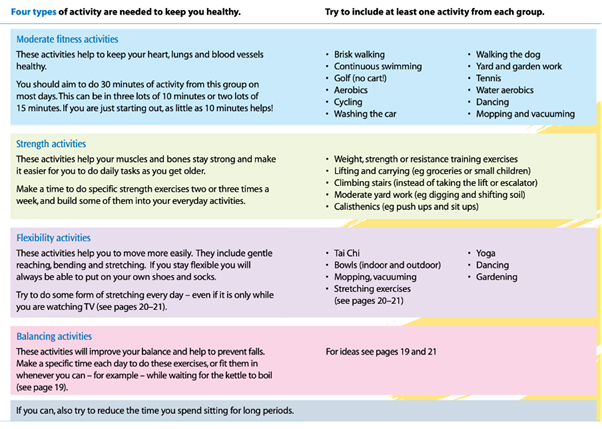Research tells us that regular exercise can be fantastic for all of us, no matter how old (or young) we are.
According to the global initiative, Exercise is Medicine, exercise has some amazing brain-boosting effects. Exercise can decrease anxiety, it can improve your memory and concentration and has even been shown to increase the size of your brain! It has been shown to decrease the risk of developing Alzheimer’s disease by up to 30 per cent and can be as effective as medication for decreasing depression.
Exercise also has immune-boosting effects and is associated with a significant decrease in the risk of breast cancer recurring and up to a 50 per cent decrease in the incidence of diabetes. It also improves sleep quality and decreases the risk of developing a chronic disease.
Read more: Study shows link between exercise and heightened immunity
Exercise has a huge impact on heart and lung health, decreasing the risk of having a stroke by 27 per cent. It improves risk factors for cardiovascular disease such as high cholesterol and obesity and decreases the incidence of high blood pressure by almost 50 per cent. It improves cardiovascular fitness, exercise capacity and resting heart rate.
Exercise also has numerous benefits for the musculoskeletal system. It builds strong bones to prevent osteoporosis, it helps to prevent falls, it can decrease joint and arthritis pain, it keeps the body strong and impacts our ability to work inside and outside the home, as well as keeping us social with friends and family.
So why do so many people believe that exercise doesn’t or won’t work for them?
This is where exercise is more like medicine than you think. Exercise can be amazing, and it can make you look and feel great but only if you do the right sort of exercise, at the right dosage and in the right way.
If your doctor told you to take your medication three times a day, would you take it all in the morning? Or would you take your heart medication to fix your sore hip? Absolutely not. And this is where choosing the right sort of exercises and the right dosage is so important.
Read more: Does sex count as exercise?
Strength exercises build strong muscles and strong bones. They are important for keeping your joints happy, controlling arthritis, maintaining strong tendons and rebuilding after an injury. You should aim to do this type of exercise a few times a week.
Fitness exercises improve your cardiovascular fitness (your heart, lungs and blood vessels). Current Australian guidelines suggest that Australians over 65 should aim to do at least 30 minutes of moderate fitness exercise on most days. Taking the dog for a walk, playing doubles tennis and working in the garden are all great ways of achieving this.
Flexibility exercises or stretches are more important for some people than others but are great for keeping you moving well, lubricating arthritic joints, improving your posture (and mood) and relieving muscles aches and tension.
Some people should stretch daily while others need only stretch a few times a week, but it is always best to stretch after you have exercised rather than before.
Balance exercises get more important as we get older. They are one of the main tools for preventing falls, but are also important if you injure an ankle or knee. They improve your proprioception, which is how your brain knows where your body is in space. You should aim to do balance exercises every day.
Read more: Study finds this exercise can add years to our lives
So which type of exercise is right for you?
Choosing how to exercise can be tricky and you might like to speak with your physiotherapist, doctor or exercise professional for help getting started.
Start with something easy and fun. Doing it with a friend can make it easier to be motivated and setting some goals can also help on the days you would rather stay on the couch.
The ‘Choose Health: Be Active’ guidelines released by the Australian government include a great table to give you some hints.

YourLifeChoices and the Sydney University research team want to help older Australians manage musculoskeletal pain, stay active, thrive – and beat back pain.
We’re partnering with researchers from the University of Sydney’s Charles Perkins Centre Musculoskeletal Research Hub on ‘the buddy trial’ – a program that aims to not only get you moving, but also to enhance the physical and mental benefits of exercise.
If you are interested in finding out more, please visit the Sydney University website and tell them the YourLifeChoices team sent you. Or you can complete the pre-screening form.
Kate Roberts is an experienced physiotherapist and PhD candidate at the University of Sydney. She has a passion for helping older Australians to manage their aches and pains, and is particularly interested in helping people stay active and strong. When not working, she is kept busy with her three children and two dogs and a secret dedication to pointing her toes and leaping in her regular ballet class.
Which type of exercise is best for you? What is your preferred exercise? Do you exercise with a friend? Why not share your exercise suggestions in the comments section below?
If you enjoy our content, don’t keep it to yourself. Share our free eNews with your friends and encourage them to sign up.

